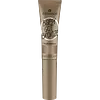What's inside
What's inside
 Key Ingredients
Key Ingredients

 Benefits
Benefits

 Concerns
Concerns

 Ingredients Side-by-side
Ingredients Side-by-side

Ricinus Communis Seed Oil
MaskingOctyldodecanol
EmollientNeopentyl Glycol Dicaprylate/Dicaprate
EmollientCI 77220
Cosmetic ColorantKaolin
AbrasiveIsostearyl Alcohol
EmollientOryza Sativa Bran Wax
Skin ConditioningEuphorbia Cerifera Wax
Cocos Nucifera Oil
MaskingDisteardimonium Hectorite
StabilisingTocopheryl Acetate
AntioxidantGlyceryl Caprylate
EmollientPentaerythrityl Tetra-Di-T-Butyl Hydroxyhydrocinnamate
AntioxidantAluminum Hydroxide
EmollientParfum
MaskingCI 77491
Cosmetic ColorantCI 77492
Cosmetic ColorantCI 77499
Cosmetic ColorantCI 77891
Cosmetic ColorantRicinus Communis Seed Oil, Octyldodecanol, Neopentyl Glycol Dicaprylate/Dicaprate, CI 77220, Kaolin, Isostearyl Alcohol, Oryza Sativa Bran Wax, Euphorbia Cerifera Wax, Cocos Nucifera Oil, Disteardimonium Hectorite, Tocopheryl Acetate, Glyceryl Caprylate, Pentaerythrityl Tetra-Di-T-Butyl Hydroxyhydrocinnamate, Aluminum Hydroxide, Parfum, CI 77491, CI 77492, CI 77499, CI 77891
Water
Skin ConditioningCoconut Alkanes
EmollientIsoamyl Laurate
EmollientSilica
AbrasiveTalc
AbrasivePropanediol
SolventTri (Polyglyceryl-3/Lauryl) Hydrogenated Trilinoleate
EmulsifyingAloe Barbadensis Leaf Juice
Skin ConditioningPolyglyceryl-4 Isostearate
EmulsifyingDisteardimonium Hectorite
StabilisingCoco-Caprylate/Caprate
EmollientSodium Chloride
MaskingSodium Hyaluronate
HumectantTocopherol
AntioxidantCaprylic/Capric Triglyceride
MaskingTriethoxycaprylylsilane
Sodium Gluconate
Skin ConditioningDiethylhexyl Syringylidenemalonate
Skin ProtectingEthylhexylglycerin
Skin ConditioningPhenoxyethanol
PreservativeParfum
MaskingCI 77491
Cosmetic ColorantCI 77492
Cosmetic ColorantCI 77499
Cosmetic ColorantCI 77891
Cosmetic ColorantWater, Coconut Alkanes, Isoamyl Laurate, Silica, Talc, Propanediol, Tri (Polyglyceryl-3/Lauryl) Hydrogenated Trilinoleate, Aloe Barbadensis Leaf Juice, Polyglyceryl-4 Isostearate, Disteardimonium Hectorite, Coco-Caprylate/Caprate, Sodium Chloride, Sodium Hyaluronate, Tocopherol, Caprylic/Capric Triglyceride, Triethoxycaprylylsilane, Sodium Gluconate, Diethylhexyl Syringylidenemalonate, Ethylhexylglycerin, Phenoxyethanol, Parfum, CI 77491, CI 77492, CI 77499, CI 77891
Ingredients Explained
These ingredients are found in both products.
Ingredients higher up in an ingredient list are typically present in a larger amount.
Ci 77491 is also hydrated iron III oxide. It's sole purpose is to give a red/pink hue to products.
Iron III oxides are classified as inorganic chemicals for coloring.
Synthetically created Ci 77491 is considered safer than those naturally found. This is because the synthetically created version may contain less impurities. Iron oxides are generally non-toxic and non-allergenic.
Learn more about CI 77491Ci 77492 is also hydrated iron III oxide. It's sole purpose is to give a yellow hue to products.
Iron III oxides are classified as inorganic chemicals for coloring.
Synthetically created Ci 77492 is considered safer than those naturally found. This is because the synthetically created version may contain less impurities. Iron oxides are generally non-toxic and non-allergenic.
Learn more about CI 77492Ci 77499 is also hydrated iron III oxide. It is created from mixing red and black iron oxides. This helps give shades of darkness to a product.
Iron III oxides are classified as inorganic chemicals for coloring.
Ci 77891 is a white pigment from Titanium dioxide. It is naturally found in minerals such as rutile and ilmenite.
It's main function is to add a white color to cosmetics. It can also be mixed with other colors to create different shades.
Ci 77891 is commonly found in sunscreens due to its ability to block UV rays.
Learn more about CI 77891Disteardimonium Hectorite comes from the clay mineral named hectorite. It is used to add thickness to a product.
It can also help stabilize a product by helping to disperse other ingredients.
Hectorite is a rare, white clay mineral.
Learn more about Disteardimonium HectoriteParfum is a catch-all term for an ingredient or more that is used to give a scent to products.
Also called "fragrance", this ingredient can be a blend of hundreds of chemicals or plant oils. This means every product with "fragrance" or "parfum" in the ingredients list is a different mixture.
For instance, Habanolide is a proprietary trade name for a specific aroma chemical. When used as a fragrance ingredient in cosmetics, most aroma chemicals fall under the broad labeling category of “FRAGRANCE” or “PARFUM” according to EU and US regulations.
The term 'parfum' or 'fragrance' is not regulated in many countries. In many cases, it is up to the brand to define this term.
For instance, many brands choose to label themselves as "fragrance-free" because they are not using synthetic fragrances. However, their products may still contain ingredients such as essential oils that are considered a fragrance by INCI standards.
One example is Calendula flower extract. Calendula is an essential oil that still imparts a scent or 'fragrance'.
Depending on the blend, the ingredients in the mixture can cause allergies and sensitivities on the skin. Some ingredients that are known EU allergens include linalool and citronellol.
Parfum can also be used to mask or cover an unpleasant scent.
The bottom line is: not all fragrances/parfum/ingredients are created equally. If you are worried about fragrances, we recommend taking a closer look at an ingredient. And of course, we always recommend speaking with a professional.
Learn more about Parfum